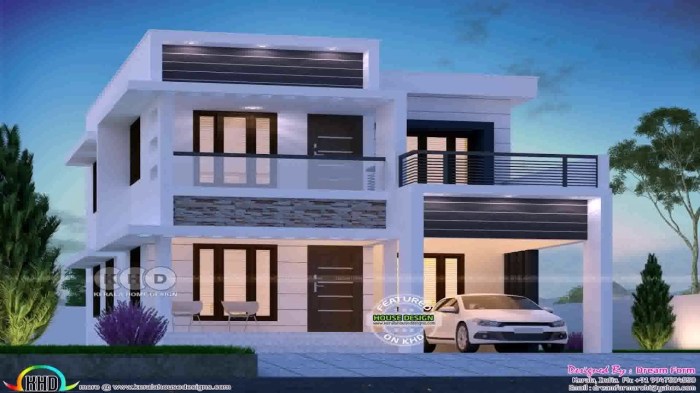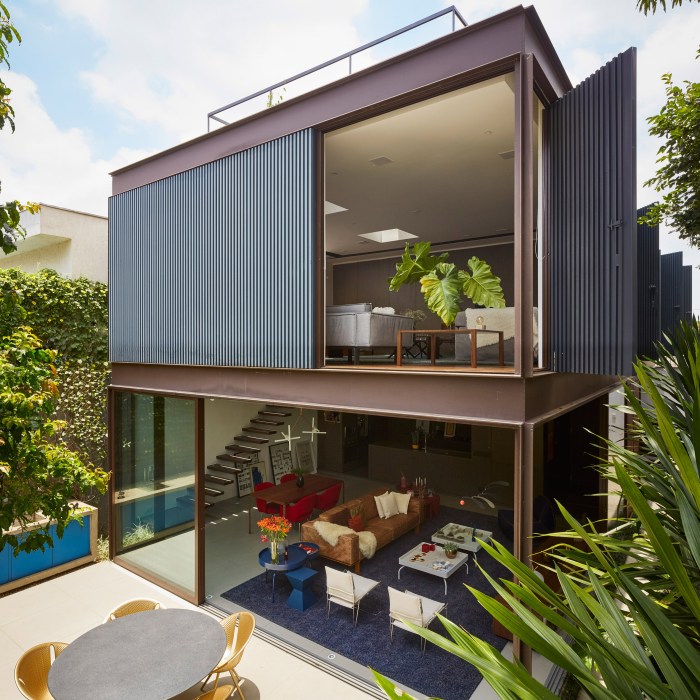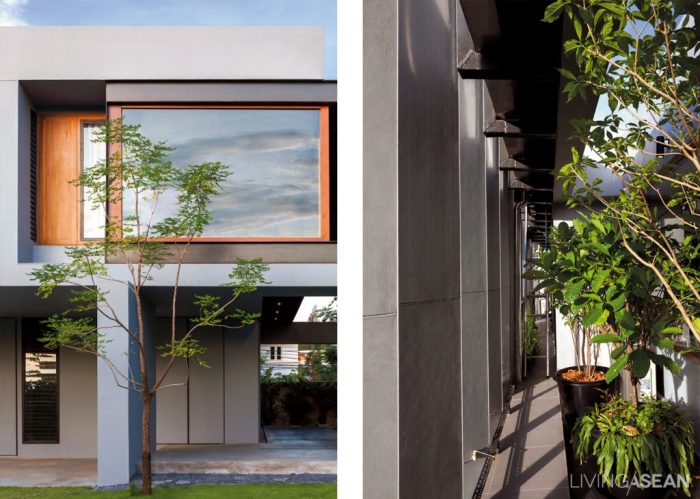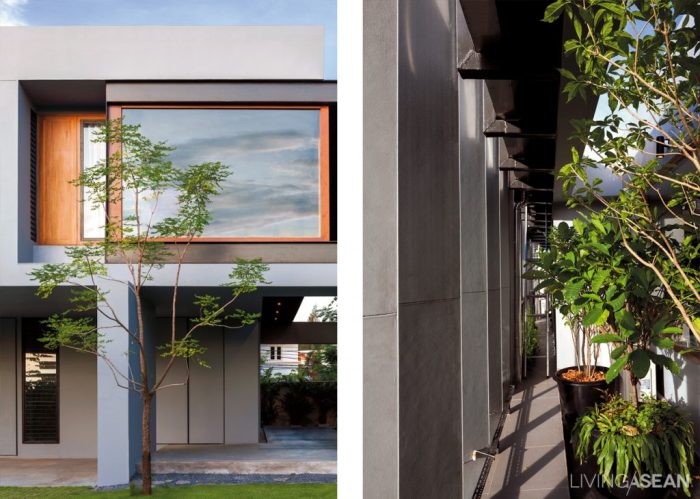Box type house interior design presents a unique challenge and opportunity. These homes, characterized by their simple, geometric forms, offer a blank canvas for creativity. The key to maximizing their potential lies in understanding the interplay of light, space, and functionality.
From carefully selecting furniture that complements the architecture to incorporating strategic color palettes and textures, box type houses can be transformed into havens of style and comfort. This guide explores the essential design principles and techniques for achieving a harmonious and visually appealing interior within the constraints of this architectural style.
Defining the Box Type House

The box type house, also known as the cube house or rectangular house, is a popular architectural style characterized by its simple, geometric design. This style prioritizes functionality and efficiency, making it a practical and cost-effective option for homeowners.
Characteristics of Box Type Houses
Box type houses are defined by their rectangular or square shape, with a straightforward layout and minimal ornamentation. They often feature flat roofs, large windows for natural light, and a simple facade. This minimalist design emphasizes clean lines and a sense of openness.
Examples of Box Type House Designs
The box type house design has evolved over time, leading to diverse variations.
- Modern Box Type Houses:These designs often incorporate large expanses of glass, open floor plans, and minimalist interiors. They may feature cantilevered balconies or terraces, adding a dynamic element to the structure.
- Traditional Box Type Houses:These designs often feature more traditional elements, such as gabled roofs, porches, and brick exteriors. They may have a more formal layout, with separate rooms for different functions.
- Minimalist Box Type Houses:These designs focus on simplicity and functionality. They often feature a limited palette of materials, such as concrete, steel, and wood, and minimal ornamentation.
Advantages of Box Type House Designs, Box type house interior design
Box type houses offer several advantages, making them an attractive choice for many homeowners.
- Cost-Effectiveness:The simple design and straightforward construction process of box type houses make them relatively inexpensive to build.
- Energy Efficiency:The compact design of box type houses can minimize heat loss and gain, leading to lower energy bills.
- Versatility:The adaptable design of box type houses allows for various configurations, accommodating different family sizes and lifestyles.
- Easy Maintenance:The simple exterior and interior of box type houses make them easy to maintain and clean.
Disadvantages of Box Type House Designs
While box type houses offer numerous benefits, they also have some drawbacks.
- Limited Architectural Interest:The minimalist design of box type houses can sometimes be perceived as lacking in architectural interest or visual appeal.
- Lack of Privacy:The large windows and open floor plans common in box type houses can compromise privacy, especially in urban areas.
- Limited Customization:The simple design of box type houses may limit the potential for customization and unique features.
Creating a Sense of Space
While box type houses offer a sense of security and structure, they can sometimes feel cramped and confined. To counter this, strategic design choices can visually expand the interior and create an illusion of greater space.
Color and Light
Color plays a crucial role in shaping our perception of space. Lighter colors like white, cream, and pale pastels reflect light, making a room appear larger. Conversely, darker colors tend to absorb light, making spaces feel smaller. This principle can be applied strategically to create the desired effect.
For example, using lighter colors on walls and ceilings can make a room feel more expansive, while darker colors can be used for accent walls or furniture to add depth and contrast. Natural light is a powerful tool for creating a sense of spaciousness.
Maximizing natural light by using large windows and skylights can significantly enhance the feeling of openness. Placement of windows is also important. Windows positioned high on the walls can make a room feel taller, while windows facing the garden can bring the outdoors in and create a sense of continuity.
Artificial lighting also plays a role. Avoid harsh overhead lighting, which can create shadows and make a room feel smaller. Instead, opt for softer, diffused lighting, such as lamps and sconces. Layered lighting with multiple sources can create a more inviting and spacious atmosphere.
Furniture Placement
The placement of furniture can have a significant impact on the perceived size of a room. Avoid placing furniture against walls, as this can make the space feel smaller. Instead, try grouping furniture away from the walls, creating a sense of openness and flow.
This also allows for more walking space and creates a more inviting layout. Using multi-functional furniture, such as sofa beds or ottomans with storage, can also help to maximize space. These pieces serve multiple purposes, minimizing the need for additional furniture and maximizing the available floor area.
Mirrors and Reflective Surfaces
Mirrors are excellent tools for creating the illusion of space. They reflect light, making a room appear brighter and larger. Strategically placed mirrors can double the visual space, especially in small rooms. For example, placing a large mirror opposite a window can create a sense of depth and openness.
Reflective surfaces, such as polished metal or glass, can also contribute to the feeling of spaciousness. Using these materials for furniture, accessories, or even wall finishes can reflect light and create a more expansive atmosphere.
Window Placement and Size
Window placement and size significantly influence the feeling of spaciousness. Large windows allow ample natural light to flood the room, making it feel more expansive. Windows positioned high on the walls can make a room feel taller, while windows facing the garden can bring the outdoors in and create a sense of continuity.
In addition to their size, the design of windows can also impact the feeling of space. Arch windows, for example, can create a sense of grandeur and height, while bay windows can add depth and dimension to a room.
Maximizing Natural Light

A box-type house, with its simple, rectangular form, can sometimes feel closed off and lacking in natural light. However, with strategic planning and design choices, you can transform this into a bright and airy space.
The key to maximizing natural light in a box-type house is to carefully consider the placement and size of windows, as well as the use of light-reflective materials and colors.
Maximizing Window Placement and Size
The placement and size of windows are crucial for optimizing natural light flow. In a box-type house, consider these strategies:
- Large Windows:Maximize the size of windows, especially on the south-facing side of the house, to allow for maximum sunlight penetration. Larger windows create a more open and spacious feel, and let in more natural light.
- Multiple Windows:Instead of one large window, consider using multiple smaller windows. This creates a more dynamic light pattern and can make the space feel more inviting.
- High Windows:Use high windows, especially in rooms where you want to maximize natural light while maintaining privacy, like bathrooms or bedrooms. These windows allow light to penetrate deep into the room, creating a sense of openness and brightness.
- Skylights:Consider incorporating skylights to introduce light into the center of the house, where it might otherwise be limited. Skylights can dramatically enhance the brightness of a room, especially those with limited wall space for windows.
Incorporating Texture and Pattern
Adding texture and pattern to the interior of a box type house can transform a simple space into a visually captivating and inviting environment. These elements add depth, visual interest, and personality to the otherwise clean lines and geometric shapes characteristic of this architectural style.
Utilizing Materials for Texture and Pattern
The choice of materials plays a crucial role in creating texture and pattern within the box type house. By incorporating a variety of materials, you can achieve a multi-dimensional and dynamic aesthetic.
- Wood: Wood is a versatile material that offers a wide range of textures and patterns. From the smooth grain of polished hardwoods to the rustic charm of reclaimed wood, there’s a wood type to suit every style. For example, using rough-hewn wood beams on the ceiling can add a touch of rusticity, while incorporating sleek wooden panels on the walls can create a modern and sophisticated look.
- Textiles: Textiles provide an excellent opportunity to introduce color, pattern, and texture. Upholstery fabrics, curtains, rugs, and throw pillows can all be used to create a cozy and inviting atmosphere. Consider incorporating a variety of textures, such as velvet, linen, wool, and cotton, to add visual interest and tactile appeal.
- Stone: Stone is a durable and elegant material that can bring a touch of natural beauty to the interior. Natural stone, such as marble, granite, or slate, can be used for countertops, flooring, or accent walls. The unique patterns and textures of stone add a sense of sophistication and timeless elegance.
Strategic Pattern Application
Patterns can be used strategically to enhance the overall design scheme of a box type house. By incorporating patterns in a thoughtful manner, you can create a cohesive and visually appealing interior.
- Geometric Patterns: Geometric patterns, such as stripes, chevrons, and polka dots, can add a modern and playful touch to the interior. Consider using geometric patterns on rugs, pillows, or wallpaper to create a focal point or add visual interest to a particular area.
- Floral Patterns: Floral patterns can add a touch of femininity and romance to the interior. Choose floral patterns in muted tones for a sophisticated look or opt for bold and vibrant prints for a more dramatic effect. Consider using floral patterns on curtains, upholstery fabrics, or artwork to create a sense of vibrancy and life.
- Abstract Patterns: Abstract patterns, such as swirls, waves, or organic shapes, can create a sense of movement and energy within the space. Abstract patterns can be incorporated into artwork, rugs, or even on accent walls to add a unique and contemporary touch.
Creating Focal Points
In the minimalist canvas of a box-type house, strategically placed focal points are crucial for injecting visual interest and depth. They draw the eye, create a sense of movement, and elevate the overall aesthetic appeal.
Strategic Placement of Furniture
Focal points are effectively established by thoughtfully positioning furniture. A well-placed sofa, a statement armchair, or a carefully curated bookshelf can instantly transform a space. These pieces become visual anchors, inviting the eye to linger and appreciate the design elements around them.
Illuminating Focal Points with Lighting
Lighting plays a vital role in accentuating focal points. A strategically placed pendant light above a dining table, a dramatic floor lamp illuminating a corner art piece, or a warm spotlight highlighting a textured wall can create a sense of drama and emphasize specific areas.
The goal is to use lighting to highlight, not overpower, the focal point.
Artworks as Focal Points
Artworks are powerful tools for creating focal points. A large abstract painting, a collection of framed photographs, or a captivating sculpture can instantly transform a blank wall into a captivating feature. The size, color, and subject matter of the artwork should complement the overall design scheme and create a sense of visual balance.
Examples of Focal Point Strategies
- A fireplace in the living room can be highlighted with a custom-built mantel, a statement mirror, and a strategically placed rug.
- A dining table can be transformed into a focal point with a dramatic chandelier, a centerpiece of fresh flowers, and a collection of elegant chairs.
- A reading nook can be created by placing a comfortable armchair in a corner, adding a floor lamp, and decorating the space with a bookshelf and a few personal touches.
Incorporating Personal Touches
A box-type house, while offering a clean and modern aesthetic, can sometimes feel a bit sterile. Injecting personality into the design is crucial to transform it into a warm and inviting home. Incorporating personal touches allows you to express your unique style and create a space that truly reflects you.
Personalizing with Art and Decor
Adding personal items like artwork, photographs, and mementos can instantly transform a space from generic to unique. These items serve as conversation starters, reminders of cherished memories, and expressions of your individual taste.
- Art:Whether it’s a collection of paintings, prints, or sculptures, art can infuse personality into any room. Consider the style of your home and choose artwork that complements it. For a modern box-type house, abstract or contemporary art can be a great fit.
- Photographs:Photographs are a powerful way to personalize a space and create a sense of warmth. Frame your favorite family photos, travel memories, or even vintage snapshots and display them on walls, shelves, or even create a dedicated photo wall.
- Mementos:These are items that hold sentimental value, such as souvenirs from trips, handmade crafts, or even childhood toys. They add a personal touch and create a sense of history and nostalgia. Display mementos in a way that complements the overall design aesthetic, perhaps on a bookshelf, coffee table, or in a glass-front cabinet.
Creating a Cohesive Design
When incorporating personal touches, it’s important to maintain a cohesive design aesthetic. This means ensuring that your personal items complement the overall style of the house.
- Color Palette:Choose personal items that align with the color palette of your home. If your home features neutral tones, consider adding pops of color through artwork, throw pillows, or even a vibrant rug.
- Style:Ensure that the style of your personal items aligns with the overall style of your home. For example, if you have a modern box-type house, avoid adding overly traditional or rustic elements.
- Scale:Consider the size of your personal items in relation to the size of the room. Overly large or small items can disrupt the visual balance of the space.
Personalizing Furniture
Furniture can also be a great way to incorporate personal touches.
- Fabric:Choose furniture fabrics that reflect your style. You can add a touch of personality with unique patterns, textures, or colors.
- Upcycling:Give old furniture a new lease on life by upcycling it. This can involve painting, reupholstering, or adding new hardware. Upcycled furniture adds a unique touch and can be a great way to incorporate vintage or antique elements.
Final Wrap-Up: Box Type House Interior Design

Ultimately, box type house interior design is about creating a space that reflects your personality and lifestyle. By embracing the unique characteristics of this architectural style, you can craft an interior that is both stylish and functional, a place where you can truly feel at home.
Whether you prefer a minimalist aesthetic, a vibrant eclectic approach, or something in between, the possibilities are endless.
FAQ Overview
What are some common challenges with box type house interior design?
One common challenge is creating a sense of depth and visual interest in a space that can feel somewhat limited. Another is maximizing natural light flow, especially in homes with smaller windows.
How can I make a box type house feel more spacious?
Using light colors, mirrors, and strategically placed furniture can help create the illusion of more space.
What are some tips for choosing furniture for a box type house?
Choose furniture with clean lines and simple designs that won’t overwhelm the space. Multi-functional pieces can also be helpful for maximizing space utilization.

